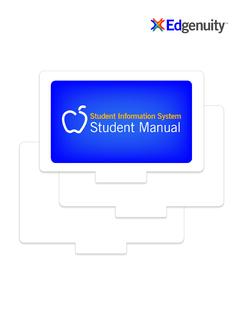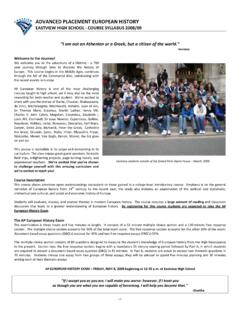Transcription of a AP® World History Syllabus - Edgenuity Inc.
1 AP World History Syllabus a Page 1 | AP World History Syllabus Edgenuity Inc. Course Description AP World History is a yearlong college-level course designed to prepare students for the advanced placement (AP) World History Exam. The goal of this course is to explore historical themes common to societies around the World and across time periods, from prehistory to the present day. Emphasis is placed on critical and evaluative thinking skills, essay-writing, interpretation of original documents, and historiography.
2 Students will demonstrate their understanding and acquisition of skills through written work, document-based questions, project-based activities, and practice exams. Historical Themes Throughout this course, students will be exposed to five historical themes. These themes, which tap into the big ideas in World History , allow students to identify trends and make connections across six historical time periods. Theme 1: Interaction between Humans and the Environment Demography and disease Migration Patterns of settlement Technology Theme 2: Development and Interaction of Cultures Religions Belief systems, philosophies, and ideologies Science and technology The arts and architecture Theme 3.
3 State-Building, Expansion, and Conflict Political structures and forms of governance Empires Nations and nationalism Revolts and revolutions Regional, transregional, and global structures and organizations AP World History Syllabus a Page 2 | AP World History Syllabus Edgenuity Inc. Theme 4: Creation, Expansion, and Interaction of Economic Systems Agricultural and pastoral production Trade and commerce Labor systems Industrialization Capitalism and socialism Theme 5: Development and Transformation of Social Structures Gender roles and relations Family and kinship Racial and ethnic constructions Social and economic classes Key Concepts Key concepts are used to organize the course by six time periods.
4 This Syllabus references the key concepts as identified by the College Board . The key concepts help students understand, organize, and prioritize historical developments within each era. Key Activities Historical thinking skills acquisition: Throughout the course, students will be asked to complete key activities that tap into the four major historical thinking skills analyzing historical sources and evidence, making historical connections, chronological reasoning, and creating and supporting a historical argument.
5 Primary and secondary source analysis: In these activities, students will examine primary and secondary sources, including maps, charts, speeches, diaries, letters, personal ideologies, official documents, traditional stories, and more. Students will analyze these sources to make connections across places and time periods and to identify common themes. Essays and writing assignments: Throughout the course, students will have regular writing assignments that will require them to analyze primary and secondary sources; draw comparisons; argue and support opinions; identify similarities and differences among events, groups of people, and places; and identify causes and effects.
6 AP World History Syllabus a Page 3 | AP World History Syllabus Edgenuity Inc. There are several long essays in the course that require students to compare and contrast, analyze cause and effect, analyze continuity and change over time, and evaluate for periodization. Throughout the course, students practice writing responses to AP World History style short-answer questions. Document-based questions (DBQs): Students will also work through document-based questions (DBQs) as part of their writing and their historical analysis of primary and secondary sources.
7 These questions will mimic the types of DBQs that students will experience on the AP World History Exam. Projects: Students will complete two major research projects during the course. In the first semester, students will create a multimedia presentation that compares and contrasts imperial governments from 600 CE to 1450 CE. Students will choose from a list of empires to analyze. In the second semester, students will create a multimedia presentation that analyzes continuities and changes in gender roles across each of the six periods of AP World History .
8 Students are expected to include evidence from societies and cultures from each region. Course Materials Textbook Strayer, Robert W. Ways of the World : A Global History with Sources for AP. 2nd ed. Boston: Bedford/St. Martin s, 2013. Reader Reilly, Kevin. Worlds of History , A Comparative Reader for advanced placement . 5th ed. Boston: Bedford/St. Martin s, 2013. Primary sources Students will read and analyze selected primary sources included in Strayer and Reilly, as well as individual selections from a wide variety of other sources.
9 See course outline below for specific selections. AP World History Syllabus a Page 4 | AP World History Syllabus Edgenuity Inc. Secondary sources Beard, Mary R. Women as a Force in History : A Study in Traditions and Realities. Persea Books, 1987. Hochschild, Adam. King Leopold's Ghost: A Story of Greed, Terror, and Heroism in Colonial Africa. Houghton Mifflin, 1999. Kelly-Gadol, Joan. Did Women have a Renaissance , from Women, History , and Theory: The Essays of Joan Kelly-Gadol. Wiesner-Hanks, Merry E., et.
10 Al. Discovering the Global Past: A Look at the Evidence, Vol. I. Cengage Learning, 2011. Other works of historical interpretation used in the course are taken from Reilly. See course outline below for specific selections. Course Outline Unit 1: Technological and Environmental Transformations to 600 BCE Key Concepts Key Concept Big Geography and the Peopling of the Earth Key Concept The Neolithic Revolution and Early Agricultural Societies Key Concept The Development and Interactions of Early Agricultural, Pastoral, and Urban Societies Topics for Overview Human origins and the Neolithic Revolution Early peoples and civilizations of the Fertile Crescent Egyptian and Nubian cultures Textbook Reading Strayer 2013, ch.


















